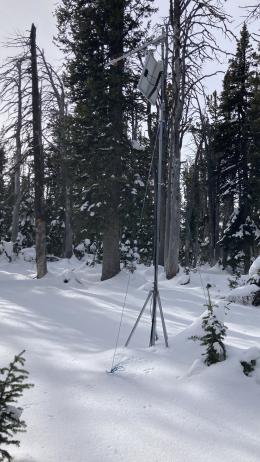This is Dave Zinn with pre-season avalanche, weather and event information for the Gallatin National Forest Avalanche Center on Friday, November 17th. This information is sponsored by Alpine Yamaha in Livingston and Highline Partners.
Generally dry conditions with daily temperatures peaking in the 30s and 40s persisted this week with moderate to strong winds gusting into the 50s and 60s mph from the west to southwest. The dry spell was briefly interrupted by 1-2” of snow on Sunday, November 12, in the southern regions of the forecast area. Daily high temperatures in the mountains will cool to the 20s and 30s by Sunday with chances of snowfall Sunday and in the middle of next week, giving us hope that the extended fall will eventually move on
Our warm fall continued at lower elevations, with wheels and hiking boots feeling more appropriate than sleds and boards. However, the story at higher elevations is different. Skiers and riders in the Bridger and Northern Gallatin Ranges and near Cooke City have reported avalanches in the last two weeks (avalanche activity log). This included skier-triggered slides in The Great One (11/8) and on Mount Blackmore (11/12). Both of these slides occurred in steep, high-consequence terrain and, thankfully, had happy endings. Anyone traveling in snow-covered terrain, whether they be a skier, rider, hunter, climber, or hiker, should adhere to the avalanche fundamentals. Avoid steep slopes or take precautions by traveling with a partner, carrying avalanche gear, including a beacon, shovel, and probe, and only exposing one person at a time to steep slopes.
Conditions generally trended toward stability during our warm week without new snow, but strong wind built thick drifts on some slopes. Treat slopes with large mounds of wind-loaded snow with suspicion by testing and looking for signs of instability or avoiding them.
Stability and strength are not synonymous, while stability has improved, our thin, early-season snowpack is weakening as it transforms into sugary facets. This is the foundation upon which our snowpack will be built. On Wednesday, Ian saw evidence of this weakening while working on weather stations in the Centennial Mountains (observation and photos). When winter finally arrives, snow will fall on a layered snowpack composed of weak facets on many upper-elevation slopes. At lower elevations, snow will fall on dirt, and the evolution of the snowpack will begin.
We are grateful to the groups who have reported avalanches so far this season. These observations help us provide the broader community with life-saving information. Your observations are more important than ever during the early season as we get to know this season’s developing snowpack. If you get out, please share avalanche, snowpack or weather observations via our website, email (mtavalanche@gmail.com), phone (406-587-6984), or Instagram (#gnfacobs).
We’ll update the Weather and Avalanche Log daily and issue pre-season bulletins as needed throughout the fall as conditions warrant.
Avalanche season is here at higher elevations. Natural and human-triggered avalanches in the last two weeks are clear evidence of this. Slopes with large drifts of wind-loaded snow are the most likely to slide. While stability has improved in the week without new snow, adhere to avalanche fundamentals whenever you are near steep snow-covered slopes. Carry rescue gear, expose a maximum of one person at a time to steep slopes, and watch and test for signs of instability.
On Wednesday, Ian saw evidence that the 20” of snow at 8800’ is weakening at our Sawtelle Weather Station. This will be the foundation of this season’s snowpack (observation and photos).
Our education calendar is full of awareness lectures and field courses. Check it out: Events and Education Calendar.
We are offering an Avalanche Fundamentals with Field Session course targeted towards non-motorized users in December and January, and one geared towards motorized users in January. Sign up early before they fill up.
Take these early season conditions seriously - early season avalanches in southwest Montana have seriously injured and buried skiers (2012 Incident Report), caught and injured hunters (2015 Incident Report), and resulted in tragic fatalities (2017 Incident Report).
Sadly, North America's first avalanche fatality of the season occurred in British Columbia on November 11. Read more about the accident here.


